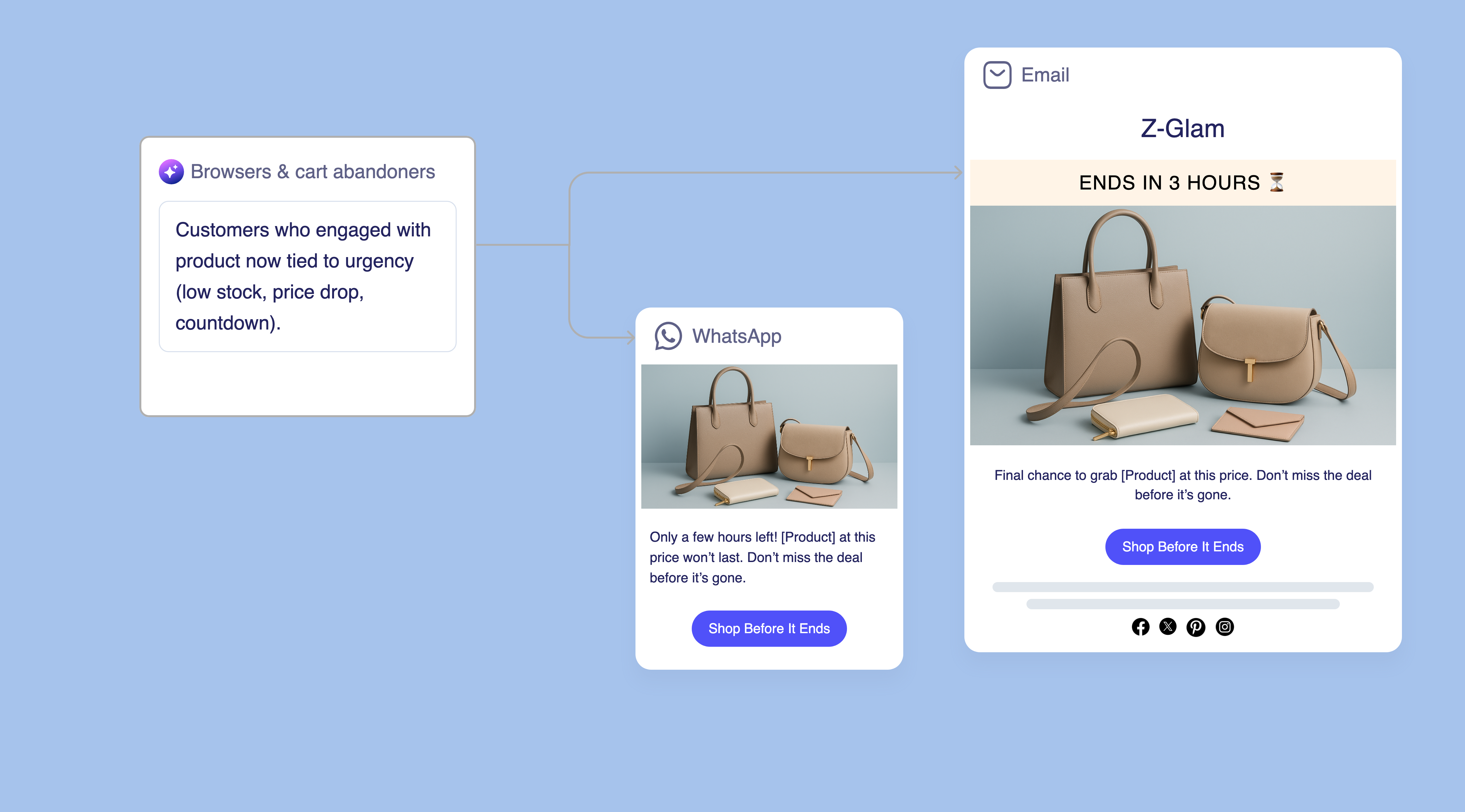
Create Urgency
Convert browsers and cart abandoners into buyers by leveraging timers, scarcity, and limited-time messaging to drive immediate action.

What are Urgency Campaigns?
Urgency Campaigns target browsers and cart abandoners with time-based or inventory-based triggers that encourage immediate action. Whether it’s a timer counting down, a low-stock alert, or a limited-period deal, these campaigns create FOMO (fear of missing out) and drive faster conversions.
Why Urgency Campaigns Matter

Challenges

Opportunities
Outcomes
Higher Conversion from Hesitant Browsers
Reduced Cart Abandonment Rates
Increased Revenue from Time-Sensitive Offers
Who is it for?
Audience
Exclusions
How it Plays Out
A sample sequence for this use case.
Ends in 3 hours! Final chance to grab [Product] at this price → [CTA]
Only a few hours left! [Product] at this price won't last → [Link]
Last call! This offer expires in 1 hour → [Act Now]
Final minutes remaining! Don't miss out → [Buy Now]
Best Practices
- Use authentic urgency based on real inventory levels or genuine time constraints rather than artificial scarcity tactics.
- Include specific time remaining ("3 hours left") rather than vague urgency language to create concrete pressure.
- Focus urgency campaigns on products customers actually viewed or added to cart for maximum relevance and impact.
Create Urgency Examples & Prompts
Channel Examples
Automate with Zenie Prompts
Managing timers, inventory levels, and urgency triggers requires real-time monitoring and precise timing coordination. With Zenie, you can automatically create urgency campaigns based on actual scarcity and time constraints.

Segment users who engaged with product now tied to urgency (low stock, price drop, countdown)
Explore Similar eCommerce Marketing Strategies
FAQs
Why are urgency campaigns effective for eCommerce conversion?
Urgency campaigns work because they trigger fear of missing out (FOMO) and reduce decision paralysis by creating clear deadlines for action. D2C marketers see higher conversion rates when customers feel they must act immediately rather than having unlimited time to decide.
How should eCommerce brands create authentic urgency without appearing manipulative?
D2C businesses should base urgency on real constraints like actual inventory levels, genuine sale end dates, or limited production runs. Avoid fake countdown timers that reset or artificial scarcity claims that damage customer trust for eCommerce marketers.
What types of urgency triggers work best for different customer segments?
Time-based urgency works well for deal-seekers, inventory scarcity appeals to exclusivity-minded customers, and limited-edition messaging resonates with trend-conscious buyers. D2C brands should match urgency types to customer motivations and behaviors.
Should urgency campaigns be used frequently or sparingly for maximum impact?
eCommerce businesses should use urgency campaigns strategically rather than constantly to maintain effectiveness. Overuse of urgency tactics can create "urgency fatigue" where customers become immune to time pressure messaging for D2C marketers.
How do eCommerce businesses measure urgency campaign effectiveness?
Track conversion rates during urgency periods, revenue generated from time-sensitive offers, cart abandonment reduction, and customer response rates to urgency messaging. Monitor whether urgency-driven buyers show similar repeat purchase patterns as regular customers for D2C marketers.

